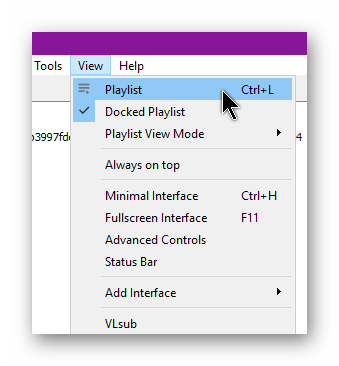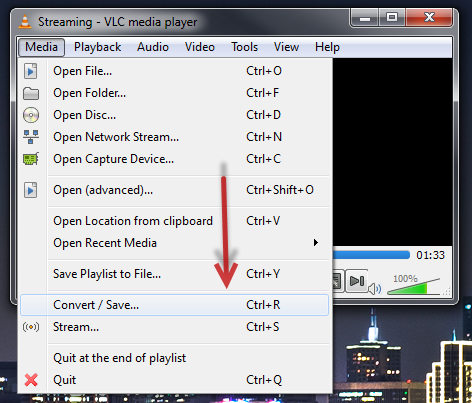Bookmarks Do Not Save In Vlc For Mac
Powerful and user-friendly as VLC is, chances are that some M4V format files in your video folder can't directly play using VLC. Different from the common video formats like MP4, MOV, AVI, FLV and WMV, you need to convert.M4V to the VLC supported formats. So today we are going to share the information about how you can play M4V files with VLC on your computer easily. Part 1. What Is A M4V File M4V file is a video format developed by Apple Corporation to encode their TV series, music videos on the iTunes store.
This format is completely same as MPEG-4 video format and even video codec except for FairPlay DRM copy protection which is provided added by Apple, causing people can't fail to play these videos with VLC media player. To play these M4V format video files you need an authorized computer with iTunes and the same Apple account you used to purchase the M4V video. How to Play M4V Files with a VLC Media Player on Windows VLC media playersupports most popular audio and video formats except some. M4V format is just one of exceptions, it is the DRM protection on the video files making it not possible to be played directly in the VLC media player. Even users can’t play this format after buying from Apple iTunes store. If you are looking to play M4V file in the VLC media player then there is good news for you, you can easily play M4V video format in the VLC media player by converting the format to the VLC supported format first(skip to Part 5 to know about How to Convert M4V for Play in VLC Media Player), or download iTunes and sign in the Apple account you used to buy the videoon your Windows computer.


How to Play M4V Files with a VLC Media Player on Mac If you are considering playing the M4V files on your Mac via the VLC media player, then the corresponding solutions are just like what we provide for Windows users. You need to convert these files to other formats, such as from M4V to MP4 format, only then you'll be able to play M4V files in VLC media player on Mac. Another way is to sign in Apple account that you used to buy videos from iTunes store, then you can play these files on iTunes, but note that this doesn't play with VLC. Why VLC Cannot Play Some M4V Files VLC media player is open source media player software which supports some video formats. This software supports MPEG (ES,PS,TS,PVA,MP3), AVI, ASF/WMV/WMA, MP4/MOV/3GP, OGG/OGM/Annodex, Matroska (MKV), WAV (including DTS) formats only.
Namely, VLC can't play M4V files by default. What's more, the DRM copyright protection of M4V files from Apple can't be removed, so the only workable way is to convert.M4V to other compatible formats for VLC media player. How to Convert M4V for Play in VLC Media Player Wondershare Video Converter Ultimate is such a wonderful software and enables you to convert M4V for playing in VLC media player. It's so amazing that allows you to convert M4V videos to MP4 or other 150+ formats in a few clicks only. This software also acts as a video converter, DVD burner, downloader and video streamers. It is such a comprehensive video solution that you can't miss the following key features. Converts M4V file to other VLC supported formats so as to play.M4V in VLC media player.
Convert video to over 1000 formats, like AVI, MKV, MOV, MP4, etc. Convert video to optimized preset for almost all of the devices.
30X faster conversion speed than other common converters. Edit, enhance & personalize your videos. Burn video to playable DVD with attractive free DVD template. Download or record videos from video sharing sites, like YouTube, Dailymotion, Vimeo, etc. Versatile toolbox includes fixing video metadata, GIF maker, casting video to TV, VR converter and screen recorder.
Supported OS: Windows 10/8/7/XP/Vista, Mac OS 10.14 (Mojave), 10.13, 10.12, 10.11, 10.10, 10.9, 10.8, 10.7, 10.6. Step 2 Add M4V files.
Bookmarks Do Not Save In Vlc For Mac Windows 10
After launching program,you'll under the Convert section Converting tab by default. Add files here from your local computer either by drag and drop file or click on Add Files button on the interface. One pop-up window will open, you just need to select the M4V files you want to convert and click on Open button afterwards. Step 3 Select the output format. Once your M4V videos are added to the program, you can choose your desired video format by clicking the drop-down icon beside Convert all files to: and select Video the video format like MP4 the detailed preset. There are over 1000 formats available for your selection. Note: You can create your custom default output format as well by clicking on Create Custom button.
Step 4 Convert M4V files to the target format. Finally click on Convert All button to start the conversion process. You can find this button in the bottom right corner. After the conversion completes, you can find the converted files in the Converted tab, right-click on the video and select the Open File Location option to find the output folder.
I love VLC Player. It doesn’t sully my playback experience with silly plugins. On the contrary, it plays almost any video format I can throw at it and is chock-full with options. In a previous post but there still one little thing that wants to curtail my gushing Most video players automatically save and restore the position of the last played meda file. In other words, the player will remember the playback position; usually saving it on exit. But VLC Player fails here. The current version of 2.1.5, but it still doesn’t allow you save the playback position.
So what’s the workaround? Is there a workaround? A quasi-solution Yes, there is a workaround but my answer is qualified. (meaning it has a proviso attached) If you’re running VLC Player version 2.0 or 2.1, you can that adds a new “ Save/restore position of the last played files” option in Preferences under Interface.
There’s also a different extension called which accomplishes the same feat; however, it’s beleaguered by the same problem as it peer: you need to be on an antiquated VLC version. The obvious problem with this, of course, is that you’re fettered to version 2.0 and 2.1. Now there may be a few folks out there who revere those versions; however, it’s always best to run the latest because of the preponderance of bug fixes and other enhancements. A better way You can circumvent the problem with a little workaround that involves Playback bookmarks. Just as a browser bookmark saves the location of a web site, a playback bookmark saves the time location of your video or audio file. I currently don’t know of a way to automate this but you can use keyboard shortcuts so the problem isn’t so egregious. Just open a video or audio file in VLC Player and while it’s playing press Ctrl + b to open the Custom Bookmark manager.
Click Create then Close and the current position is saved. You can retrieve the playlist position by pressing Alt + l + b (that’s an “L”) and using the arrow keys to find load your save point. The Bottom Line Remembering the file position in VLC Player has actually been. But I think the widespread desire for a “Save playback position” feature is an augury that it will eventually make it’s way to the final product build. We just need to wait!
If you can’t wait, either downgrade and use the srpos extension or embrace custom bookmarks. If both options are unacceptable, you can ditch VLC Player and which offers native support for remembering playback positions. Like VLC Player,; however, in my opinion, the user interface isn’t commensurate with VLC Player but then again – that’s just a peccadillo. Here you can see it playing a video I captured while visiting Wengen, Switzerland with my wife. We rented a villa and this was our backyard. Incidentally, the above image captures the unadulterated, bucolic splendor of Wengen. Pastoral cabins really line verdant hills and alpine white mountains stretch into the clouds.
It’s a beautiful place. If you ever get the chance, visit Wengen! The memories I want to go back so bad. Anyway, enough of that, what do you guys think about remembering playback in VLC Player? Have you found any workarounds of your own?
Share the gold in the comments! “doesn’t get any easier than that.” It isn’t easy at all, and it doesn’t really work. Installation, after download, requires several steps of directory creation and file moving. This addon sometimes crashes VLC so the user must force-close it. This problem is reported in the product forum and acknowledged by the creator, who doesn’t know how to fix it. Since the addon must be manually activated before it will work, double-clicking on a file always starts running it at the beginning.
So, for me and maybe most users, the addon just does not work. I’m going back to writing the current playback position in a file, then on reload doing a manual reposition.
The proper fix cannot be done in a LUA addon, but requires fixing VLC itself. Sometimes product authors have a blind spot, and this seems to be the case here. VLC will probably never have an automatic save and restore of the current file positions. Too bad, because VLC is reliable, customizable, and functional in all other ways.
We recommend that you create a new rescue media every time you upgrade your Mac OS X to a newer version. When the progress is complete, disconnect the media and keep it in a safe place. You can store your own data on the media, but make sure that you do not delete or modify the Acronis boot files. Acronis true image 11 download.